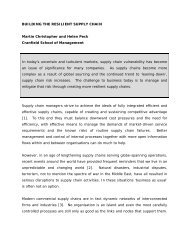Free to Download - SCLG
Free to Download - SCLG
Free to Download - SCLG
You also want an ePaper? Increase the reach of your titles
YUMPU automatically turns print PDFs into web optimized ePapers that Google loves.
Consumerism<br />
REAL REPORT<br />
manufacturers never <strong>to</strong>uch the products<br />
they sell. Given the challenges we know that<br />
exist in a consumer-driven supply chain, it<br />
is not surprising that client expectations of<br />
outsource providers have increased.<br />
We are seeing a gap develop between<br />
services rendered and the expectations of<br />
manufacturers. According <strong>to</strong> the 11th Annual<br />
Third-Party Logistics Survey 2006<br />
by Professor John Langley Jr., Ph.D.,<br />
Georgia Institute of Technology, “3PL users<br />
clearly expect continuous improvements in<br />
service levels and information technology<br />
(IT) capabilities. Among the key challenges<br />
for the 3PL industry in the future are capacity<br />
management and innovation. While 3PL<br />
users acknowledge innovations such as<br />
lead logistics providers and fourth-party<br />
logistics providers, signifi cant room for<br />
improvement still exists in the knowledge<br />
and use of these approaches.”<br />
There are a number of potential<br />
reasons for the emergence of<br />
this expectation gap:<br />
Supply chain value spans across<br />
traditional supply chain functions<br />
The domain expertise of many providers<br />
is deep within traditional supply chain<br />
functions. Many of the effi ciencies within<br />
these functions have already been gained<br />
and are no longer enough. Clients are<br />
turning now <strong>to</strong> seek value in the <strong>to</strong>tal<br />
integration of their supply chains across<br />
these functions.<br />
Fragmented systems infrastructure<br />
resulting from acquisitive growth<br />
Within the 3PL and contract manufacturing<br />
space there has been a surge in large<br />
consolidations developing through<br />
acquisition. Unfortunately, there is a<br />
lag existing in many cases within the<br />
consolidation of disparate legacy<br />
systems, despite the fact that the<br />
capabilities are marketed under a single,<br />
unifi ed global brand.<br />
Alignment within the supply<br />
chain<br />
One third of Hau Lee’s Triple A supply<br />
chain examines alignment issues within<br />
supply chain. Due <strong>to</strong> the deep functional<br />
origins of many providers, there may often<br />
be confl icting objectives in serving clients.<br />
For many providers there is a real potential<br />
danger if they expand their supply chain<br />
service portfolio <strong>to</strong> make their core business<br />
more attractive. This raises the possibility<br />
for 3PLs, repair providers and contract<br />
manufacturers <strong>to</strong> provide expanded solutions<br />
<strong>to</strong> ship more product, repair more product<br />
or build more product respectively. Contrast<br />
this desire with the typical OEM objective of<br />
creating a dynamic and optimal alignment<br />
between supply and market demand.<br />
Raising the standard<br />
As distinctions between the traditional BPO<br />
labels become blurred, those that will make<br />
a tangible difference <strong>to</strong> clients are those<br />
that come equipped <strong>to</strong> solve real cus<strong>to</strong>mer<br />
supply chain problems. How do you deal<br />
with issues such as demand variability,<br />
SKU proliferation and channel volatility<br />
in a global marketplace? How can you<br />
effectively link supply chain strategy,<br />
visibility and execution capabilities?<br />
These problems—whether in-house or<br />
outsourced—are beyond the realm of<br />
isolated domain expertise or technology only<br />
solutions. These challenges are leading <strong>to</strong><br />
the emergence of a new category of supply<br />
chain BPO that is only recently attracting the<br />
attention of the analyst community.<br />
Probably closer <strong>to</strong> the traditional notion<br />
of a 4PL, providers in this space will bring<br />
a true supply chain focus and cus<strong>to</strong>mer<br />
alignment <strong>to</strong> their business.<br />
Recent research articles from AMR<br />
Research highlight a tremendous opportunity<br />
in this space for providers, but it is<br />
contingent <strong>to</strong> the appropriate investments<br />
May 2010 Link 45

















